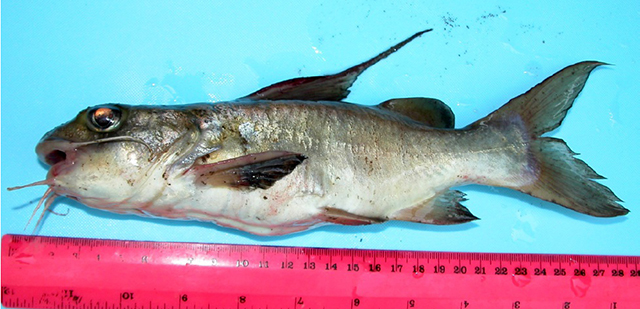| Claroteidae (Claroteid catfishes), subfamily: Claroteinae |
| 57 cm TL (male/unsexed); 35 cm SL (female); max.weight: 900.0 g |
|
demersal; freshwater; brackish, potamodromous |
| Africa: known from most of the West African hydrographic basins, except in the coastal areas between Gambia and Liberia, where it is replaced by Chrysichthys maurus (Ref. 7324, 57126). Present from southern Liberia to Cabinda (Angola) (Ref. 57126), and widespread throughout Lower Guinea (Ref. 81642). Also reported from the Chad (Ref. 3236, 57126) and Nile (Ref. 3236, 2988, 28663, 78586) basins. |
|
Dorsal spines (total): 2-2; Dorsal soft rays (total): 5-6; Anal spines: -0. Diagnosis: 1st branched dorsal-fin ray longest, nearly always extended into a long filament that may reach, or even exceed, the base of the caudal fin; in some individuals or populations (Mafou on the upper Niger; rivers Cross, Ogowe, Nyong; Sanaga estuary) this filament is strongly reduced, but the first branched ray remains the longest (Ref. 57126, 81642). In other populations this filament is particularly elongate (Sanaga mainstream and coastal rivers of Cabinda)(Ref. 81642). Usually 8 branched rays in pectoral fins (Ref. 57126, 81642), rarely 7 or 9 (Ref. 57126, 81642), 2nd and 3rd rays sometimes filamentous (Ref. 57126). Exhibits pronounced intraspecific variability, and a clinal series can be demonstrated in the size of the adipose fin and the number of gill rakers (Ref. 81642). Either 9-13 gill rakers on lower limb of first gill arch and base of adipose fin longer than dorsal-fin base (Nilo-Sudanese region = populations from Nile, Chad, Senegal and the upper courses of the Niger, Comoé, Benue and Volta), or 12-15 lower gill rakers and base of adipose fin shorter than, or equal to, dorsal-fin base (coastal zones from Liberia to Cabinda); populations from the middle and lower courses of coastal rivers in this region are more or less intermediate in regard to these characters (Ref. 57126, 81642). Pronounced dimorphism between mature males in reproductive activity and immature males (Ref. 57126, 81642).
Description: nasal barbels present; very short first dorsal spine; well developed second spine, weakly denticulate along posterior margin; pelvic fin with 1 unbranched and 5-6 branched soft rays; anal fin with 2-6 unbranched and 6-10 branched soft rays (Ref. 57126). Pronounced dimorphism between mature males in reproductive activity and immature males, affecting in particular the shape of head and fins; in mature males, the head becomes globose/inflated, and the premaxillary tooth plate, as well as the mouth, become broader, fins and spines become relatively shorter and the dorsal fin filament may disappear altogether; the extent of these modifications is highly variable from one individual to another and can therefore not be quantified; the width of the premaxillary tooth plate represents normally less than 1/5 of head length and may increase up to 1/3 of head length in mature males; the mouth width is about equal to snout length in non-mature individuals, but may reach up to 1.5 times the snout length after sexual maturation (Ref. 57126, 81642). However, specimens are always identifiable as the premaxillary dentition only occupies 40-69% of the mouth opening (Ref. 81642).
Coloration: usually rather uniform; live specimens often with yellowish or golden reflections (hence the species name), but estuarine populations are more silvery; preserved specimens may lose these reflections, becoming uniformly brownish on head and back and whitish on belly; dorsal, caudal and adipose fins commonly black-edged; often a black spot behind gill cover (Ref. 57126, 81642). |
| In those parts where Chrysichthys maurus and Chrysichthys auratus overlap (from Liberia to Ghana, to the east of the Volta), C. auratus does not enter rivers, but remains in estuaries and lagoons, where both species are sympatric; in the coastal region, C. auratus has been reported as C. filamentosus (Ref. 57126). Found in lakes and coastal rivers (Ref. 3236) and appears to tolerate a certain amount of salt (Ref. 78218). Occurs usually over soft, slightly muddy substrates or substrates with heavy layers of leafy detritus in deep, relatively quiet waters (Ref. 6868). Feeds on mollusks and small crustaceans (Branchiopods, Copepods, Ostracoda) which it digs from the substrate (Ref. 27935), and also on insects (Ref. 28714) and fish (Ref. 28714, 78218). |
|
Least Concern (LC); Date assessed: 30 April 2019 Ref. (130435)
|
| harmless |
|
Source and more info: www.fishbase.org. For personal, classroom, and other internal use only. Not for publication.

